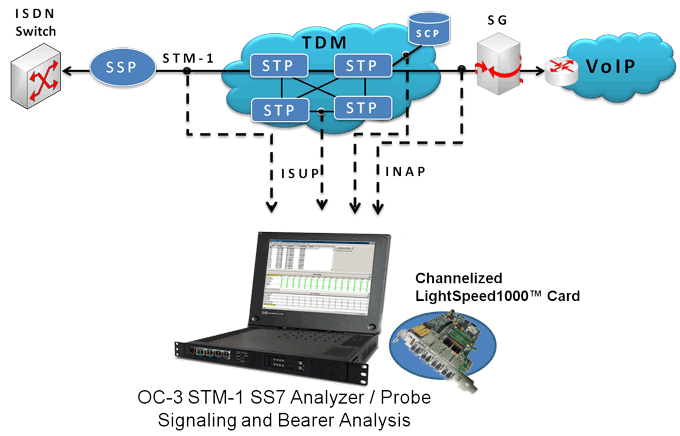Direct Access to T1 E1 DS0 on OC-3/12 STM-1/4 on LightSpeed1000™
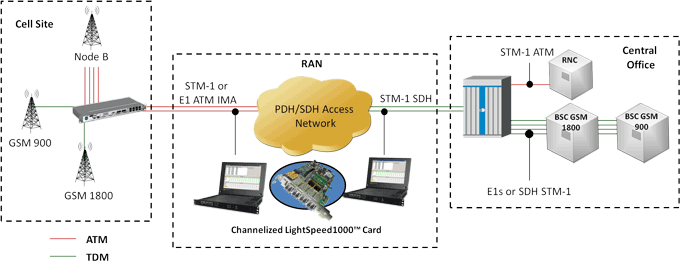
Overview
Voice, data, and video traffic is exploding as smartphones, IP TV, video streaming, and "cloud" based services takeoff. A majority of the backbone transport for these applications continues to be SONET and SDH optical transmission networks. A dominant protocol for IP transport is PoS (Packet over SONET) and another is ATM (Asynchronous Transfer Mode). Both schemes are packet based, with ATM using fixed size packets of 53 bytes called "cells", and PoS using variable packet sizes closely matching to Ethernet frames.
SONET and SDH transmission network also continue to be used for conventional channelized traffic – carrying many TDM T1, E1, T3, and E3 pipes.
GL's LightSpeed1000™ hardware platform (PCIe Card and USB Pod) is capable of OC-3/12 and STM-1/4 wire-speed processing on quad optical ports for functions such as wire-speed recording and wire-speed playback of Unchannelized and Channelized ATM, PoS, and RAW Traffic.
Two ports out of the 4 ports are meant for SONET/SDH unchannelized and unframed data. The remaining two ports are meant for SONET/SDH channelized data of carrying many independent unframed/framed T1, E1, T3, and E3 streams.
The LightSpeed1000™ comes with software for overall monitoring, BERT, emulation, and protocol analysis with a price tag that compares very favorably with similar test instruments at three times the price.
In an OC-3/STM-1, all 84 T1s or all 63 E1s can be identified and processed in transmit and receive modes. In an OC-12/STM-4, all 336 T1s or all 252 E1s can be identified and processed in transmit and receive modes. The hardware can also be easily configured / programmed for delaying of ATM Cells or PPP packets.
GL Communications has the following variants of OC-3/STM-1 and OC-12/STM-4 Analyzers:
- Quad OC-3/STM-1 and OC-12/STM-4 PCI-Express card (Windows® 7 and above 32-bit, 64-bit)
- Portable Quad OC-3/STM-1 and OC-12/STM-4 Unit (Windows® 7 and above 32-bit, 64-bit)
The card's multiple connectivity using PCIe, Gigabit Ethernet (GigE), USB 2.0 and onboard DDR2 memory makes it suitable for many applications.
Multiple cards are possible in a PC for analysis of four or more directions simultaneously. USB 2.0 interface is used to connect with a Notebook PC for portability. GigE Ethernet ports for testing RAW, BER, RFC2544, RAW SONET/SDH, and Ethernet bridge applications. The hardware is firmware FPGA based making it easy to upgrade in the field for application versatility.
A unique feature of the card is the capability to capture, transmit and process at wirespeed to/from applications and hard disk on all interfaces. An API Toolkit allows users to develop specialized applications.
Please visit LightSpeed1000™ for more details.
Main Features
- Allows to configure the number of T1 E1 channels to be Multiplexed/Demultiplexed to / from OC-3/12 STM-1/4
- 2 Channelized OC-3 STM-1/OC-12 STM-4 SONET/SDH interfaces per Lightspeed1000™ card
- 2 Unchannelized OC-3 STM-1/OC-12 STM-4 interfaces per Lightspeed1000™ card
- Allows direct access to anything and everything on SONET / SDH – Framing and Payload, including structured traffic (T1, E1, STS-1, DS3 etc) or unstructured traffic (ATM, PoS, etc).
- Supports all "basic applications" and "special applications" for T1 or E1 channels
- Comprehensive analysis / emulation of voice, data, fax, protocol, analog, and digital signals, including echo and voice quality testing
- Supports BERT, and Capture and Playback applications
- Supports Protocol Analysis of structured protocols – HDLC, ISDN, CAS, and more.
- Direct access to any or all T1s and E1s
- 2 x 336 T1’s x 24 DS0s = 16,128 DS0s
- 2 x 252 E1’s x 30 DS0s = 15,624 DS0s
- Scans the received STM-4/STM-1 traffic and identifies the mapping, tributary type [T1/E1], equipped/unequipped status of the tributaries
- Broadcasts the selected T1/E1 channel data on all the 252 E1’s or 336 T1’s
- Supports any combination of DS0/64/56/16/8 kbps fractional T1/E1, and N x T1/E1 interface definitions (a total of 252 E1s or 336 T1s – in each port )
- Supports multiplexing multiple T1 or E1 channels to a single channelized OC-3/12 STM-1/4 line
- User configurable OC-3/12 STM-1/4 mapping – allows user-defined T1 and E1 channels to multiplex. The channel numbering is same as in demultiplexer
- User configurable idle code to fill the channels when the user added channels do not have data to multiplex.
- Unused channels will be treated as unequipped.
Comparison of Channelized OC-3/STM-1 Test Solutions
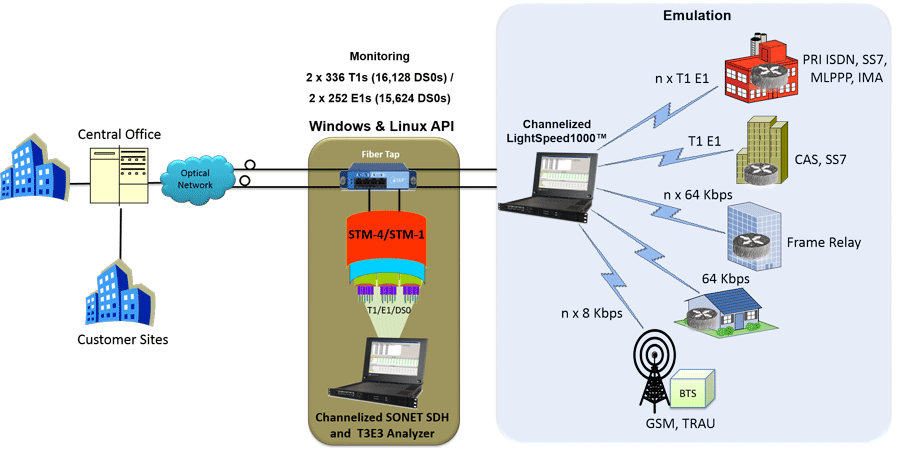
The above image depicts 2 solutions for testing channelized OC-3/STM-1 lines. The first solution shows an external multiplexer and demultiplexer hardware providing the channelized information to multiple T1 E1 access cards such as GL’s Octal T1 E1 cards for analysis and emulation. This solution would require multiple PCs, T1 E1 access cards, and numerous cables adding to the cost and complexity of the entire solution.
A more simpler solution is provided by GL’s Channelized LightSpeed1000™ board, which supports direct access to all or user-defined 2 x 336 T1s or 2 x 252 E1s per card for analysis and simulation – all within a one pc. With this hardware, any combination of DS0/64 kbps, fractional T-1/E-1, and N x T1/E1 interface definitions can be accessed for performance monitoring.
SONET/SDH Data Rates
- SONET is the North American standard (termed OC-N) defined in Telcordia GR-253-CORE and ANSI T1.105. STS-1 (Synchronous Transport Signal Level -1) is the basic level of electrically framed signal format in SONET. Higher-level signals are integer multiples of STS-1, creating the family of STS-N signals, for N = 1, 3, 12, 48, 192 & 768. The optical counterpart for each STS-N signal is designated as OC-N (Optical Carrier level-N).
- SDH is the Asian and European standard (termed STM-N) defined in ITU G.707 and G.708 standard. An STM-N (Synchronous Transport Module Level-N) are the frame structures used in the SDH.
- The following table details bit rates of SONET and SDH.
| North American Standards | ITU-T Designation | |||||
|---|---|---|---|---|---|---|
Electrical Level |
Optical Level |
Data Rate (Mbps) |
Payload Rate (Mbps) |
SDH Equivalent |
T1 Equivalent |
LightSpeed1000™ |
STS-1 |
OC-1 |
51.84 |
48.38 |
STM-0 |
28 T1s |
??? |
STS-3 |
OC-3 |
155.52 |
149.76 |
STM-1 |
84 T1s |
Yes |
STS-12 |
OC-12 |
622.08 |
599.04 |
STM-4 |
336 T1s |
Yes |
STS-48 |
OC-48 |
2488.32 |
2396.16 |
STM-16 |
1344 T1s |
|
STS-192 |
OC-192 |
9953.28 |
9584.64 |
STM-64 |
5376 T1s |
|
. |
. |
. |
. |
. |
. |
|
. |
. |
. |
. |
. |
. |
|
STS-3072 |
OC-3072 |
160Gbit/s |
|
STM-1024 |
86016 T1s |
|
SDH Mapping in GL’s LightSpeed1000™
The below diagram depicts various T1/E1 to STM-1 signal mapping possibilities in SDH. The paths colored in green are currently supported on the GL’s LightSpeed1000™ hardware.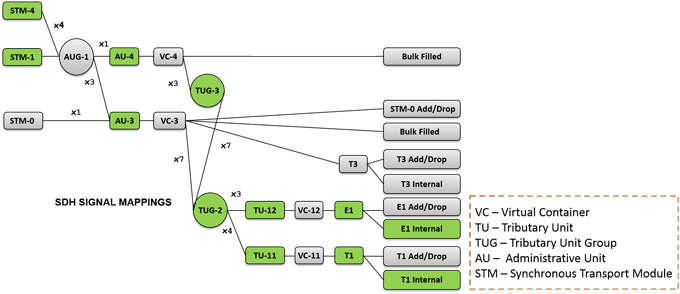
Various T1/E1 mappings in SDH:
- STM-4 --> STM-1 --> AU-3 --> TUG-2 --> TU-12 --> E1
- STM-4 --> STM-1 --> AU-4 --> TUG-3 --> TUG-2 --> TU-12 --> E1
- STM-4 --> STM-1 --> AU-3 --> TUG-2 --> TU-11 --> T1
- STM-4 --> STM-1 --> AU-4 --> TUG-3 --> TUG-2 --> TU-11 --> T1
SONET Mappings in GL’s LightSpeed1000™
The below diagram shows various T1/E1 to OC-3/12 mapping possibilities in SONET. The paths colored in green color are supported on the GL’s LightSpeed1000™ hardware.

The T1 and E1 mappings for OC-3 in SONET are as below:
- STS-12 --> OC-12 --> STS-3 --> STS-1 --> VT-Group --> VT2 --> E1
- STS-12 --> OC-12 --> STS-3c --> STS-1 --> VT-Group --> VT2 --> E1
- STS-12 --> OC-12 --> STS-3 --> STS-1 --> VT-Group --> VT1.5 --> T1
- STS-12 --> OC-12 --> STS-3c --> STS-1 --> VT-Group --> VT1.5 --> T1
Applications
Accompanying Basic Software / Features
Almost all the basic applications and optional applications supported by T1 E1 analyzers are also supported by Channelized LightSpeed1000™. For example, capturing and transmitting an entire raw OC3 / STM1, and OC12 / STM4 RAW signals simultaneously, or performing ISDN, or SS7 analysis, can be performed using the software accompanying the channelized LightSpeed1000™.
A list of all the basic applications and other optional applications (requiring additional licenses).
Some of the applications currently supported are discussed below -
Application #1: Protocol Analysis
The protocol analysis can be performed on the packets captured non-intrusively by connecting the channelized Rx Ports of LightSpeed1000™ to a Fiber Optic tap to as shown below. The LightSpeed1000™ is capable of selectively identifying and forwarding the T1, or E1 signals from OC-3/12 STM-1/4 signal streams to GL’s wide variety of protocol analysis modules such as SS7, ISDN, CAS, and more.
Application #2: Abis Monitoring
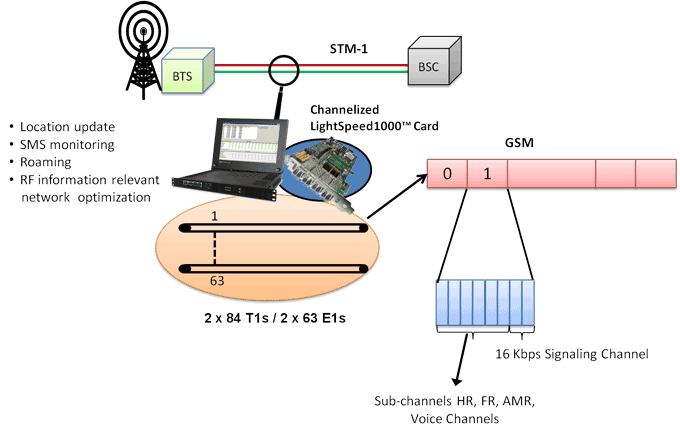
Application #3: ATM to SDH in a 3G GSM Network

Specifications
Interfaces: |
|
Alarm LEDs: |
|
Bus Interface: |
|
Power and Dimensions: |
|
Traffic |
|
Regulatory and Compliance |
|
Channelized Protocols (Structured) |
|
UnChannelized Protocols (Unstructured) |
|
Clock |
|
Functional Specifications |
Support for Channelized OC3 to T1, Channelized STM1 to E1, full, fractional, or channelized T1/E1 |
Physical Layer Alarms and Error Counts |
On SONET and SDH
T1/E1 |
Loopback Capabilities |
|
Monitoring Applications |
For T1/E1
On SONET and SDH
|
Intrusive Test Applications |
For T1/E1
|
Resource
| Item No | Item Description |
| LTS100 | Lightspeed1000™ - Dual OC-3/12 STM-1/4 PCIe Card |
LTS108 |
Any 16 Ports Chan Lic for OC3/12, STM1/4, n=1 |
| Channelized Analysis and Emulation Applications | |
|---|---|
| LTS501 LTS502 |
Basic Capability to Rx/Tx RAW OC3 / STM1 Basic Capability to Rx/Tx RAW OC12 / STM4 |
| LTS503 LTS504 |
Record Playback RAW OC3 / STM1 Record Playback RAW OC12 / STM4 |
| Related Accessories and Cables (LightSpeed1000™) | |
| IPN1310a | SFP Transceiver for for OC-3/STM-1 and OC-12/STM-4 Optical, Duplex LC, Single-Mode, 1310nm, IR (Intermediate Range, 15 km) |
| IPN850a | SFP Transceiver for OC-3/STM-1 and OC-12/STM-4 Optical, LC, Multi-Mode, 850 nm or 1310 nm |
SA019a |
1 Gbps / 10 Gbps Fiber Optic Cable, Single-Mode, Duplex LC to Duplex LC |
| SA019st | Fiber Optic T-tap, Duplex LC, Single-Mode; includes one SA019a; requires one SA019sc |
| SA019sc | Fiber Optic Analyzer Cable (Special ’Y’ Cable), Single-Mode, Duplex LC to Dual Duplex LC, 3m, Special Analyzer Cable for use with SA019st |
| SA019mt | Fiber Optic T-tap, Duplex LC, Multi-Mode; includes one SA019c; requires one SA019mc |
| SA019mc | Fiber Optic Analyzer Cable (Special ’Y’ Cable), Multi-Mode, Duplex LC to Dual Duplex LC, 3m, Special Analyzer Cable for use with SA019mt |
| SA019ska | 1GB Fiber Optic Single-Mode T-tap Kit with Required Cables and SFP Transceivers |
| SA019mka | 1GB Fiber Optic Multi-Mode T-tap Kit with Required Cables and SFP Transceivers |
| Brochure |
| Product Brochure |
| GL Product Lists |

